SCENES FROM SCIENCE
Cholesterol-intervention
EVERYBODY knows that a deposit of cholesterol accumulating in one's arter- ies prevents them transporting sufficient blood to one's heart-muscle; this in its early stages causing angina, in its final a coronary. There are two obvious modes of coping (known in the trade as `cholesterol-intervention), one diet- therapy, the other drug-therapy. Two physicians in Boston, Massachusetts, instituted separate studies of cholesterol-intervention using different drugs in their respective hospitals. How effective were the treatments in reduc- ing the incidence of coronaries and non-fatal heart-attacks? Answer: no- thing like as effective as they looked as described by the investigators! On this the two physicians conceded. No.1 opin- ing that although this were so, there was still a case for intervention; No. 2 coming out with the remarkable state- ment that trial investigators have 'a prerogative' to cast their findings 'in the most optimistic light' — which would seem to mean only one thing.
The studies were done on men, pre- dominantly the sufferers; and in the case of each drug, two groups of pa- tients were observed, one being treated with the drug, the other (the control- group) being untreated. For the first drug: in the untreated group the inci- dence of coronaries, etc, was 9.8 per cent; while in the treated group it was 8.1 per cent. So the drug had effected an absolute reduction of 1.7 per cent which is the figure a physician would want to know when deciding whether to use it. A reduction but no cause for optimism. However the investigators saw fit to describe the percentage reduc- tion relative to the percentage of coro- naries among the untreated — 1.7 per cent out of 9.8 per cent — which comes out at 17 per cent. There's an optimistic light! Unfortunately it's no help in direct evidence of the absolute results of treatment, only a help in promoting faith among the uninitiated. For the second drug: the absolute reduction was 1.4 per cent, which gave the researchers the basis for describing their results as showing a relative reduction of 34 per cent.
No. 1 had the last word, remarking that a one point something percent reduction is not necessarily to be sneezed at, especially when, as appears to be the case, it can be sustained over years. But one does speculate on the source of funds by which those two research-teams were supported.
William Cooper










































































































 Previous page
Previous page